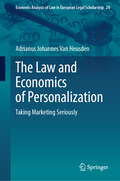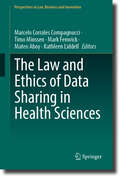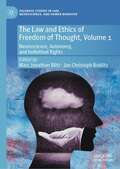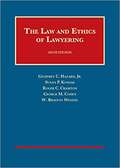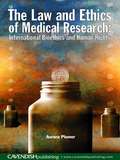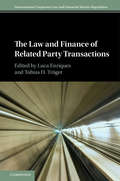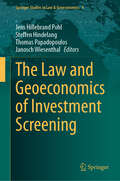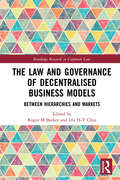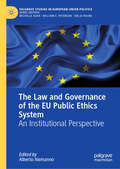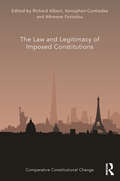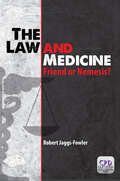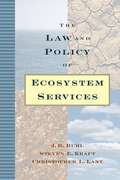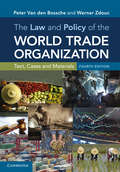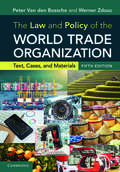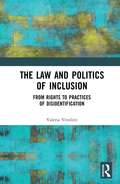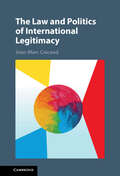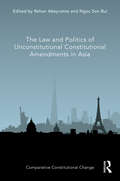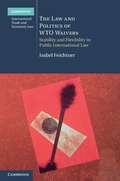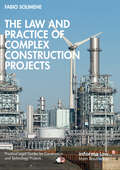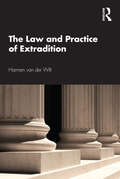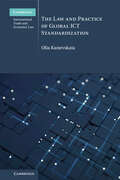- Table View
- List View
The Law and Economics of Personalization: Taking Marketing Seriously (Economic Analysis of Law in European Legal Scholarship #20)
by Adrianus Johannes Van HeusdenImagine every ad, every price, and even every contract completely tailored to you — welcome to the age of AI-driven hyper-personalization. Today, vast amounts of consumer data are collected and processed to build individualized profiles with ever-increasing precision. This enables one-to-one interactions that evolve in real time and allow firms to influence behavior with unprecedented subtlety. Personalized marketing holds the promise of meeting consumer needs more effectively and making digital experiences more relevant and efficient. Yet this seemingly customized environment raises urgent concerns about the power of such marketing to exploit cognitive biases, reshape preferences, and deepen asymmetries in digital markets. This book offers the first in-depth law and economics analysis of personalized marketing in the digital age. It examines how personalized advertising, pricing, and contracting challenge foundational principles of consumer protection and explores to what extent these practices are regulated under the current EU legal framework. The analysis shows that while existing rules provide some safeguards, they fall short of addressing the systemic risks posed by hyper-personalization. To respond to these challenges, the book develops a four-part policy approach aimed at reinforcing consumer autonomy, equity, and welfare in data-driven markets and bridging the regulatory gaps that personalization opens up. Regulating these developments involves a clear trade-off between efficiency and fairness. How much freedom do you give up in exchange for a hyper-personalized experience? How confident are you that the price you pay will not exceed what others pay for the exact same service? And what does it mean for your autonomy when an algorithm predicts your behavior better than you do yourself? This book offers a critical starting point for future regulation and a call to rethink the role of personalization in the digital economy.
The Law and Economics of a Sustainable Energy Trade Agreement
by Ricardo Meléndez-Ortiz Richard Samans Gary C. HufbauerThe widely accepted need to reduce the world's dependence on fossil fuels and move instead to low-carbon, renewable alternatives faces a host of challenges. Whilst the greatest challenges remain in engineering, political and public policy issues continue to play a very important role. This volume, which consists of contributions from leading figures in the field, presents the case for a Sustainable Energy Trade Agreement (SETA). It shows that by addressing barriers to trade in goods and services relevant for the supply of clean energy, such an agreement would foster the crucial scaling-up of clean energy supply and promote a shift away from fossil fuels. In doing so it illustrates how the agreement would help to address a number of overarching sustainable development priorities, including the urgent threat of climate change, enhanced energy access and improved energy security. The book will appeal to academics and policymakers working on the interface of trade and energy policy. Proposes a new trade agreement that will appeal to those who understand the potential of trade to contribute to sustainable development and wish to see progress. Provides a concrete positive contribution to climate action, which contrary to other climate policies comes at a low cost, with benefits for all involved. Provides rich and groundbreaking analysis, with leading experts developing their ideas in an accessible manner.
The Law and Ethics of Data Sharing in Health Sciences (Perspectives in Law, Business and Innovation)
by Mark Fenwick Marcelo Corrales Compagnucci Timo Minssen Mateo Aboy Kathleen LiddellData sharing – broadly defined as the exchange of health-related data among multiple controllers and processors – has gained increased relevance in the health sciences over recent years as the need and demand for collaboration has increased. This includes data obtained through healthcare provisions, clinical trials, observational studies, public health surveillance programs, and other data collection methods. The practice of data sharing presents several notable challenges, however. Compliance with a complex and dynamic regulatory framework is essential, with the General Data Protection Regulation being a prominent example in a European context. Recent regulatory developments related to clinical trial transparency, trade secrecy, data access, AI training data, and health data spaces further contribute to the difficulties. Simultaneously, government initiatives often encourage scientists to embrace principles of “open data” and “open innovation.”The variety of regulations in this domain has the potential to impede widespread data sharing and hinder innovation. This edited volume, therefore, compiles comparative case studies authored by leading scholars from diverse disciplines and jurisdictions. The book aims to outline the legal complexities of data sharing. By examining real-world scenarios from diverse disciplines and a global perspective, it explores the normative, policy, and ethical dilemmas that surround data sharing in the health sciences today.Chapter Patient Perspectives on Data Sharing, Chapter Supplementary Measures and Appropriate Safeguards for International Transfers of Health Data after Schrems II are available open access under a Creative Commons Attribution 4.0 International License via link.springer.com.
The Law and Ethics of Freedom of Thought, Volume 1: Neuroscience, Autonomy, and Individual Rights (Palgrave Studies in Law, Neuroscience, and Human Behavior)
by Marc Jonathan Blitz Jan Christoph BublitzFreedom of thought is one of the great and venerable notions of Western thought, often celebrated in philosophical texts – and described as a crucial right in American, European, and International Law, and in that of other jurisdictions. What it means more precisely is, however, anything but clear; surprisingly little writing has been devoted to it. In the past, perhaps, there has been little need for such elaboration. As one Supreme Court Justice stressed, “[f]reedom to think is absolute of its own nature” because even “the most tyrannical government is powerless to control the inward workings of the mind.” But the rise of brain scanning, cognition enhancement, and other emerging technologies make this question a more pressing one. This volume provides an interdisciplinary exploration of how freedom of thought might function as an ethical principle and as a constitutional or human right. It draws on philosophy, legal analysis, history, and reflections on neuroscience and neurotechnology to explore what respect for freedom of thought (or an individual’s cognitive liberty or autonomy) requires.
The Law and Ethics of Lawyering
by George Cohen W. Wendel Geoffrey Hazard Jr Susan Koniak Roger CramtonThe Law and Ethics of Lawyering (University Casebook Series) 6th Edition
The Law and Ethics of Medical Research: International Bioethics and Human Rights
by Aurora PlomerThe growing globalization of medical research and the application of new biotechnologies in morally contested areas has forced a revision of international ethical guidelines. This book examines the controversies surrounding biomedical research in the twenty-first century from a human rights perspective, analyzing the evolution and changes in form and content of international instruments regulating the conduct of biomedical research. The approach adopted is comparative and includes an evaluation of human rights and UK and US law on embryonic stem cell research, the HIV/AIDS trials in the developing world, the Alder Hey Inquiry and the human radiation and nerve gas experiments on human subjects in the US and the UK. This is the first book to analyze some of the major issues in biomedical research today from an international, comparative human rights perspective.
The Law and Finance of Related Party Transactions (International Corporate Law and Financial Market Regulation)
by Luca Enriques Tobias H. TrögerA globe-spanning group of leading law and finance scholars bring together cutting-edge research to comprehensively examine the challenges legislators face in regulating related party transactions in a socially beneficial way. Combining theoretical analysis of the foundations of efficient regulation with empirical and comparative studies, readers are invited to draw their own conclusions on which regulatory responses work best under differing circumstances. The careful selection of surveyed jurisdictions offers in-depth insight into a broad variety of regulatory strategies and their interdependence with socioeconomic and political conditions. This work should be read by scholars, policymakers, and graduate students interested in a critical, much-debated area of corporate governance.
The Law and Geoeconomics of Investment Screening (Springer Studies in Law & Geoeconomics #4)
by Steffen Hindelang Jens Hillebrand Pohl Thomas Papadopoulos Janosch WiesenthalThis volume presents pioneering research for the purpose of developing a common analytical foundation and framework for the emerging interdisciplinary research field of investment control and national security. It deals with legal and regulatory aspects of investment controls, specifically from an international, transnational, and comparative law perspective.
The Law and Governance of Decentralised Business Models: Between Hierarchies and Markets (Routledge Research in Corporate Law)
by Roger M Barker; Iris H-Y ChiuThis book draws together themes in business model developments in relation to decentralised business models (DBMs), sometimes referred to as the ‘sharing’ economy, to systematically analyse the challenges to corporate and organisational law and governance. DBMs include business networks, the global supply chain, public–private partnerships, the platform economy and blockchain-based enterprises. The law of organisational forms and governance has been slow in responding to changes, and reliance has been placed on innovations in contract law to support the business model developments. The authors argue that the law of organisations and governance can respond to changes in the phenomenon of decentralised business models driven by transformative technology and new socio-economic dynamics. They argue that principles underlying the law of organisations and governance, such as corporate governance, are crucial to constituting, facilitating and enabling reciprocality, mutuality, governance and redress in relation to these business models, the wealth-creation of which subscribes to neither a firm nor market system, is neither hierarchical nor totally decentralised, and incorporates socio-economic elements that are often enmeshed with incentives and relations. Of interest to academics, policymakers and legal practitioners, this book offers proposals for new thinking in the law of organisation and governance to advance the possibilities of a new socio-economic future.
The Law and Governance of the EU Public Ethics System: An Institutional Perspective (Palgrave Studies in European Union Politics)
by Alberto AlemannoThe questions at the core of this volume are the following: What are the ethics and integrity rules for the EU? How do they score compared to the integrity frameworks existing at the Member States’ level and in other democracies? How do we design these rules and ensure their enforcement in the EU? How do we improve the enforcement of EU integrity standards? Can an EU ethics system contribute to preventing or mitigating unethical conduct within the Union thus improving its democratic legitimacy? In addressing these questions, this edited volume provides a critical analysis of the existing 'EU ethical framework' while contextualising it within the unique transnational setting that characterises the EU public administration and its various institutions.
The Law and Legitimacy of Imposed Constitutions (Comparative Constitutional Change)
by Richard Albert Xenophon Contiades Alkmene FotiadouConstitutions are often seen as the product of the free will of a people exercising their constituent power. This, however, is not always the case, particularly when it comes to ‘imposed constitutions’. In recent years there has been renewed interest in the idea of imposition in constitutional design, but the literature does not yet provide a comprehensive resource to understand the meanings, causes and consequences of an imposed constitution. This volume examines the theoretical and practical questions emerging from what scholars have described as an imposed constitution. A diverse group of contributors interrogates the theory, forms and applications of imposed constitutions with the aim of refining our understanding of this variation on constitution-making. Divided into three parts, this book first considers the conceptualization of imposed constitutions, suggesting definitions, or corrections to the definition, of what exactly an imposed constitution is. The contributors then go on to explore the various ways in which constitutions are, and can be, imposed. The collection concludes by considering imposed constitutions that are currently in place in a number of polities worldwide, problematizing the consequences their imposition has caused. Cases are drawn from a broad range of countries with examples at both the national and supranational level. This book addresses some of the most important issues discussed in contemporary constitutional law: the relationship between constituent and constituted power, the source of constitutional legitimacy, the challenge of foreign and expert intervention and the role of comparative constitutional studies in constitution-making. The volume will be a valuable resource for those interested in the phenomenon of imposed constitutionalism as well as anyone interested in the current trends in the study of comparative constitutional law.
The Law and Medicine: Friend or Nemesis?
by Robert Mark Jaggs-FowlerThe work draws together a rich tapestry of material across many different disciplines, covering the crucial relationship between medicine and law from the early apothecaries to the modern-day general practitioner. It presents an invaluable overview of the subject and offers vital background reading to anyone interested in medico-legal medicine, as well as providing a springboard for students of medicine and law interested in researching the field through its remarkable diversity of reference resources.
The Law and Policy of Ecosystem Services
by Steven E. Kraft Christopher L. Lant J. B. RuhlThe Law and Policy of Ecosystem Services is the first comprehensive exploration of the status and future of natural capital and ecosystem services in American law and policy. The book develops a framework for thinking about ecosystem services across their ecologic, geographic, economic, social, and legal dimensions and evaluates the prospects of crafting a legal infrastructure that can help build an ecosystem service economy that is as robust as existing economies for manufactured goods, natural resource commodities, and human-provided services. The book examines the geographic, ecological, and economic context of ecosystem services and provides a baseline of the current status of ecosystem services in law and society. It identifies shortcomings of current law and policy and the critical areas for improvement and forges an approach for the design of new law and policy for ecosystem services. Included are a series of nine empirical case studies that explore the problems caused by society's failure to properly value natural capital. Among the case study topics considered are water issues, The Conservation Reserve Program, the National Conservation Buffer Initiative, the agricultural policy of the European Union, wetland mitigation, and pollution trading. The Law and Policy of Ecosystem Services is a groundbreaking look at the question of whether and how law and policy can shape a sustainable system of ecosystem service management. It is an accessible and informative work for faculty, students, and policy makers concerned with ecology, economics, geography, political science, environmental studies, law, and related fields.
The Law and Policy of The World Trade Organization
by Peter Van den Bossche Werner ZdoucSince its first edition, this textbook has been the first choice of teachers and students alike, due to its clear introduction to the basic principles of the multilateral trading system and its detailed examination of the law of the World Trade Organization. The third edition continues to explore the institutional and substantive law of the WTO. Material has been restructured to closely align with teaching approaches making it even more user-friendly. It has been updated to incorporate all new developments in the WTO's body of case law. Questions and assignments are integrated to allow students to assess their understanding, while chapter summaries reinforce learning. Chapters end with an exercise reflecting real-life trade problems: these challenge students (and practitioners) and enable them to hone their analytical skills. This title is an essential tool for all WTO law students and will also serve as the practitioner's introductory guide to the WTO.
The Law and Policy of the World Trade Organization: Text, Cases and Materials
by Peter Werner Zdouc Van Den BosscheSince its first edition, this textbook has been the first choice of teachers and students alike, due to its clear introduction to the basic principles of the multilateral trading system and its detailed examination of the law of the World Trade Organization. The third edition continues to explore the institutional and substantive law of the WTO. Material has been restructured to closely align with teaching approaches making it even more user-friendly. It has been updated to incorporate all new developments in the WTO's body of case law. Questions and assignments are integrated to allow students to assess their understanding, while chapter summaries reinforce learning. Chapters end with an exercise reflecting real-life trade problems: these challenge students (and practitioners) and enable them to hone their analytical skills. This title is an essential tool for all WTO law students and will also serve as the practitioner's introductory guide to the WTO.
The Law and Policy of the World Trade Organization: Text, Cases, and Materials
by Werner Zdouc Peter Van den BosscheSince the publication of its first edition, this textbook has been the prime choice of teachers and students alike, due to its clear and detailed explanation of the basic principles of the multilateral trading system and the law of the World Trade Organization (WTO). The fifth edition continues to explore the institutional and substantive law of the WTO. It has been updated to incorporate all new developments in the WTO's ever-growing body of case law. Moreover, each chapter includes a 'Further Readings' section to encourage and facilitate research and discussion on the topics addressed. As in previous editions, each chapter also features a summary to reinforce learning. Questions, assignments, and exercises on WTO law and policy are contained in an online supplement, updated regularly. This textbook is an essential tool for all WTO law students and will also serve as a practitioner's introductory guide to the WTO.
The Law and Politics of Inclusion: From Rights to Practices of Disidentification
by Valeria VendittiOn the one hand, inclusion constitutes a powerful framework of political agency, as people can gain access to forms of recognition granting legal protection and social visibility. On the other hand, inclusion requires their adherence to fixed matrices incorporating specific and limited forms of life. This opposition reflects a similar division within the academic field: between liberal advocates of inclusion and those who regard it as a form of assimilation, where differences are absorbed and tempered. Uncovering the deficiencies in both viewpoints, this book analyzes inclusion by attending to the active role of subjects looking for inclusion, and mobilizing inclusive processes. Inclusion is thus reconceived as an ongoing, engaging movement of category-production, according to which there is no straightforward opposition between effective inclusion and assimilation. The book thus draws the idea of inclusion out of this opposition in order to delineate a form of political connectedness based on smaller social networks of solidarity that, although entailing some sort of normativity, are nevertheless characterized by fluidity and proximity. In this way, inclusion comes to be more productively, and more plausibly, reframed: as a web in which inclusive processes appear as moments of the renegotiation and rearticulation of a subjectivity in constant flux.
The Law and Politics of International Legitimacy
by Jean-Marc CoicaudThe book examines the significance of the issue of political legitimacy at the international level, focusing on international law. It adopts a descriptive, critical and reconstructive approach. In order to do so, the book clarifies what political legitimacy is in general and in the context of international law. The book analyses how international law contributes to a sense of legitimacy through notions such as international membership, international rights holding, fundamental principles and hierarchy of rights holding, rightful conduct and international authority. In addition, the book stresses the serious limitations of legitimacy of international law and of the current international order that it contributes to regulate and manage. This leads the book to identify the conditions under which international order and international law could overcome their problems of legitimacy and become more legitimate. The book is inter-disciplinary in nature, mobilizing international law, political and legal theory, philosophy, history, and political science.
The Law and Politics of Unconstitutional Constitutional Amendments in Asia (Comparative Constitutional Change)
by Rehan Abeyratne and Ngoc Son BuiThis book explains how the idea and practice of UCA are shaped by, and inform, constitutional politics through various social and political actors, and in both formal and informal amendment processes, across Asia. This is the first book-length study of the law and politics of unconstitutional constitutional amendments in Asia. Comprising ten case studies from across the continent, and four broader, theoretical chapters, the volume provides an interdisciplinary, comparative perspective on the rising phenomenon of unconstitutional constitutional amendments (UCA) across a range of political, legal, and institutional contexts. The volume breaks new ground by venturing beyond the courts to consider UCA not only as a judicial doctrine, but also as a significant feature of political and intellectual discourse. The book will be a valuable reference for law and political science researchers, as well as for policymakers and NGOs working in related fields. Offering broad coverage of jurisdictions in East Asia, Southeast Asia and South Asia, it will be useful to scholars and practitioners within Asia as well as to those seeking to better understand the law and politics of the region.
The Law and Politics of WTO Waivers
by Isabel FeichtnerDespite being an important legal instrument in the law of the WTO, the waiver has hitherto been the subject of little scholarly analysis. Isabel Feichtner fills this gap by challenging the conventional view that the WTO's political bodies do not engage in significant law-making. She systemises the GATT and WTO waiver practice and suggests a typology of waivers as individual exception, general exception and rule-making instruments. She also presents the procedural and substantive legal requirements for the granting of waivers, deals with questions of judicial review and interpretation of waiver decisions, and clarifies the waiver's potential and limits for addressing the need for flexibility and adaptability in public international law and WTO law in particular. By connecting the analysis of waiver competence and waiver practice to the general stability/flexibility challenge in public international law, the book sheds new light on the WTO, international institutions and international law.
The Law and Practice of Complex Construction Projects (Practical Legal Guides for Construction and Technology Projects)
by Fabio SolimenePresenting readers with all the need-to-know information on complex construction projects within a single publication, this book expertly focuses on practical issues whilst also providing insights on the law applying to construction projects.As well as exploring individual subjects such as the negotiation of a contract, the evaluation of a claim or assistance in relation to contractual disputes, the book also creates an overarching understanding of the entire life of a project. It presents an inside view on the various stages of complex projects, from the moment they are conceived to the end of the contractual relation between employer and contractor, including any disputes between the parties. The reader will become familiar with the terminology used in the construction industry, the various phases of complex construction projects, the law applying to each phase and the various deliverables produced by the parties throughout the project. While including sections on the law applying to each phase, the book’s primary focus is on the practical aspects faced on a daily basis by practitioners working in the construction industry.This book is important reading for professionals involved in construction law at every level, including relevant academics, government employees and lawyers. It will also serve as a useful book for students, providing a comprehensive overview of the many factors and phases of a complex construction project.
The Law and Practice of Extradition
by Harmen van der WiltThe Law and Practice of Extradition provides an in-depth overview of extradition law and practice, providing students with an understanding of how key elements have been shaped by the state, the fugitive and the international community. The process of globalisation has offered huge opportunities for organised crime, both in terms of expansion of operations and the possibility to evade justice, confronting states with considerable challenges. The Law and Practice of Extradition addresses all key topics in this fast-evolving area, including extradition and international crimes, terrorism and human rights. This textbook is particularly suitable for master's and post-doctoral students with a basic background knowledge of international law, criminal law and international relations, and will interest legal practitioners who seek a better understanding of extradition.
The Law and Practice of Global ICT Standardization (Cambridge International Trade and Economic Law)
by Olia KanevskaiaThis book presents a first comprehensive effort to explore the mechanics and fundamentals of global ICT standardization. It offers a comprehensive study of legal rules governing ICT standardization; systematically analyses governance and institutional features of some most prominent Standards Development Organizations; and presents qualitative empirical evidence on implementation of these rules in practice. By evaluating legal and procedural rules in light of current practices and tendencies in the industry, the book explores various options available for disciplining ICT standardization from the viewpoint of the applicable legislation, judiciary, and internal governance rules of Standards Development Organizations and offers practical solutions on how to increase the legitimacy of ICT standards. Adding to the previous theoretical approach to the field of standardization from historical, legal and political science perspective, this book applies theoretical considerations to unexplored scenarios, offering a holistic picture of ICT standardization and providing a novel contribution to the field.
The Law and Practice of Maritime Liens (Maritime and Transport Law Library)
by Damien J CremeanThis book uniquely offers a single point of reference on the vital legal subject of maritime liens, intrinsic to Admiralty Law and a topic often incompletely understood by shipping firms and other such businesses, to their considerable risk and detriment. Where previously it was necessary to source many different publications, of widely varying age, this book now provides a single, up-to-date, accessible and comprehensive source to explain this complex area and its implications for all parties in the maritime industry, and beyond, in each of the jurisdictions concerned.The author introduces the meaning and functions of maritime liens, as well as the jurisdictions where maritime liens arise, with some historical context provided to aid understanding. In terms accessible to anyone working within the industry, he explains the implications of maritime liens with regard to damage, pollution, collisions, salvage, wages and more. The enforcement of liens in each jurisdiction is thoroughly discussed, featuring topics such as the arrest of vessels, the exercise of liens on cargo and sub-freight, provision of security, conflict of laws, and the procedures and proceeds of judicial sales. Key priorities such as sale proceeds, competition between creditors and non-maritime claimants, are also addressed.The Law and Practice of Maritime Liens offers a comprehensive and accessible guide to the topic for anyone directly or indirectly involved in the maritime sector, but it is most directly relevant to legal practitioners (especially in maritime law and marine insurance areas) in practice within each of the relevant jurisdictions, shipowners, charterers and corporations involved in the maritime sector. Law courts, judges and magistrates throughout the English-speaking world (and elsewhere) will also benefit from this book. It is likely to have a wide international audience, being applicable to a large proportion of marine sector trade.
The Law and Practice of the Ireland-Northern Ireland Protocol
by Christopher McCruddenThe Ireland-Northern Ireland Protocol, part of the Withdrawal Agreement concluded between the European Union and the United Kingdom, is intended to address the difficult and complex impact of Brexit on the island of Ireland, North and South, and between Ireland and Great Britain. It has become an exceptionally important, if controversial, part of the new architecture that governs the relationship between the UK and the EU more generally, covering issues that range from trade flows to free movement, from North-South Co-operation to the protection of human rights, from customs arrangements to democratic oversight by the Northern Ireland Assembly. This edited collection offers insights from a wide array of academic experts and practitioners in each of the various areas of legal practice that the Protocol affects, providing a comprehensive examination of the Protocol in all its legal dimensions, drawing on international law, European Union Law, and domestic constitutional and public law. This title is also available as Open Access.
